Colorado Food Support: CSFP and Assistance Program Guide

Strong 8k brings an ultra-HD IPTV experience to your living room and your pocket.
Food insecurity is still a struggle for thousands of Coloradans. To address this, the state has established programs that would provide access to healthy food among families and seniors. Two major programs, Colorado's Commodity Supplemental Food Program (CSFP) and the Colorado Food Assistance Program (SNAP), provide vital food assistance geared to specific needs.
Combined, these programs demonstrate the state of Colorado's long-term commitment to health, nutrition, and economic assistance for at-risk residents, providing more than meals. Instead, they provide a path to stability.
1. Addressing Nutritional Needs: The Colorado CSFP
The Commodity Supplemental Food Program (CSFP) is targeted at a significant population: low-income individuals over the age of 60. Most seniors living on a fixed income cannot afford healthy meals, and this program fills the gaps.
Unlike other programs that allow for cash or digital benefits, CSFP delivers real monthly food packages intended to add to—not substitute for—a nutritious diet. The packages may contain canned fruits and vegetables, reduced-sugar cereals, shelf-stable milk, and high-protein foods such as peanut butter or beans.
Maintaining Health a Priority
As people get older, the importance of regular nutrition increases. Malnutrition can lead to the advancement of chronic diseases like diabetes, heart disease, and osteoporosis. CSFP is with this in mind, providing food that is up to USDA standards for older persons.
By promoting improved dietary habits, the program not only enhances quality of life but may also decrease healthcare expenses related to malnutrition.
Obtaining CSFP Assistance
CSFP benefits are disbursed on a monthly basis by local organizations in communities throughout Colorado. The entities include food banks, senior centers, and nonprofit organizations. Prospective recipients must be income-eligible and present identification of age and residency.
Additional details regarding eligibility and facility locations may be obtained through the Colorado Department of Human Services or by contacting participating local food banks. For specific information, see Colorado's Hunger Free Colorado website.
Upon enrollment, members are usually given a monthly food box and possibly also nutrition education materials or transfer to other health and community services.
Supporting Dignity and Autonomy
The CSFP is structured to maintain the dignity of the participants. No elaborate applications or fiscal documents beyond the essentials are required. Many centers even use drive-through or home delivery to serve those who have mobility or transport disabilities.
2. Assisting Families with the Colorado Food Assistance Program
Although CSFP is for elders, the Colorado Food Assistance Program, or SNAP, provides assistance to family households of any age who are low-income. It issues monthly electronic benefits that recipients can use at grocery stores and farmers markets to purchase eligible food.
SNAP is a federal program managed by the Colorado Department of Human Services, offering nutritional assistance to children, working individuals, seniors, and people with disabilities. It's among the most adaptable and reactive programs for individuals who are experiencing food insecurity.
Eligibility Determination
Households in Colorado must be eligible based on income and expense requirements using federal poverty guidelines to receive SNAP. Considerations are rent, childcare, medical expenses, and utility bills.
The majority of applications are done online using the Colorado PEAK system, a one-stop center that assists people in applying for various state benefit programs.
Shopping with Confidence Using Food Benefits
Participating SNAP recipients get benefits via an EBT (Electronic Benefits Transfer) card, which acts as a debit card. It's accepted in most supermarkets, some corner stores, and more and more farmers markets.
Some stores provide "Double Up Food Bucks," a program which doubles the SNAP money spent on fruits and vegetables, raising the food purchasing power for healthy food. This provides more access to fresh produce and nutrition in low-income families.
Assisting Local Agriculture and Economies
The ability to use SNAP dollars at farmers markets benefits not only families but also local producers. This creates a more robust community food system in which producers and consumers are directly linked.
Long-Term Nutrition
Food assistance programs in Colorado are designed for long-term success, rather than short-term solutions. SNAP benefits can alleviate financial pressures, enabling families to shift resources toward rent, education, or transportation.
For kids, availability of regular, nutritious meals has long-term effects on school achievement, mental health, and physical well-being. For working adults, proper nutrition enables job stability and improved health.
Program Efficiency and User Satisfaction
It is easier than ever to apply for SNAP. Online resources, automatic document upload capabilities, and responsive county office staff enable residents to initiate and complete applications with speed.
In-person support is also offered for those who want assistance from a local caseworker. Outreach campaigns are also contributing to greater awareness and less misunderstanding regarding eligibility.
Multilingual and Inclusive Outreach
Colorado provides application assistance in several languages and collaborates with community organizations to provide immigrant families, non-English language speakers, and individuals with disabilities with access to benefits without hindrances.
Working Together for a Food-Secure State
CSFP and SNAP are also part of a larger network of food banks, school lunch programs, health clinics, and nonprofit partners. These organizations assist in identifying eligible individuals and offer complementary services such as home-delivered meals or free produce distributions.
Community food drives, education campaigns, and mobile markets all serve a purpose in reinforcing Colorado's food safety net. State agency and local organization coordination is essential to see that no household slips through the cracks.
Adjusting to Changing Needs
Increased food prices and employment insecurity have boosted demand for food assistance in recent years. Colorado has reacted by expanding outreach for SNAP, broadening access to CSFP, and lobbying for supplemental funding when federal assistance varies.
These changes allow programs to continue their relevance and capacity to serve current community needs, particularly during economic crises or public health crises.
The Broader Impact on Community Health
If individuals consistently have access to nutritious food, they will be more able to control chronic diseases, stay independent for longer, and engage fully in their communities. One way to ensure this is by visiting informative sites, such as benefitsbystate.com.
Food-secure children are best able to develop, learn, and ultimately help grow the state's future economy. Well-nourished seniors are less likely to need emergency services or long-term institutional care.
Continuing the Commitment
The long-term viability of CSFP and SNAP relies on sustained state investment and collaboration with local organizations. By reaffirming the importance of these programs, Colorado continues to preserve the principle that no one needs to endure hunger by themselves.
Efforts to fortify infrastructure, streamline access, and preserve dignity for all recipients continue as the cornerstone of the future of food assistance in Colorado.
FAQs
Q1. Who can be eligible for CSFP in Colorado?
A1. Low-income residents 60 and older can be eligible. Income levels have to be below federally set levels, and verification of age and residency has to be provided.
Q2. Do Colorado farmers markets accept SNAP benefits?
A2. Yes, most farmers markets take EBT cards, and some are part of the Double Up Food Bucks program to double purchases of fruits and vegetables.
Q3. Is CSFP the same as SNAP?
A3. No. CSFP delivers a monthly box of food, whereas SNAP distributes electronic food purchase benefits. A few seniors might be eligible for both.
Note: IndiBlogHub features both user-submitted and editorial content. We do not verify third-party contributions. Read our Disclaimer and Privacy Policyfor details.



